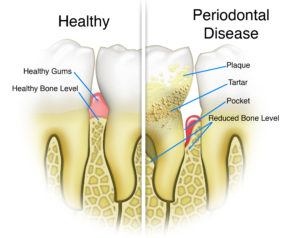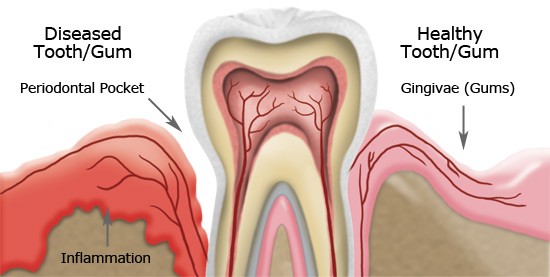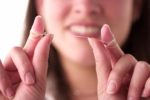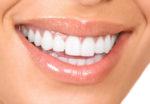Table of Contents
Healthy gums must have the following characteristics:
- light red color,
- part of gums that is beneath the teeth neck should look like orange peel,
- no bleeding on irritation, for example when brushing your teeth,
- gingival margins to the tooth should be sharp,
- part of gums between two teeth, so called interdental papilla, should completely fill that space.
The course of gingivitis and periodontal disease
 The development of gum disease (gingivitis) and periodontal disease (periodontitis) is accompanied by inflammation and tissue degradation processes. The end result of is loosening and tooth loss. Bacteria activity from dental plaque first lead to inflammation of the gums (gingivitis). If untreated, inflammation from gums crosses to other supporting tissue of the tooth. So, we can say that the initial symptom of periodontal disease is actually occurrence of gingivitis. It is characterized by weaker or stronger inflammation of the gums. This process begins in the part of the gums between the teeth (named interdental papilla). It then extends to the rest of the gums. Lastly, the advanced stage of seizes the entire gums. The color change begins from mild redness. If gingivitis lasts long time, gums become livid red. Gums are swollen and painful. They bleed at the slightest touch, but also spontaneously.
The development of gum disease (gingivitis) and periodontal disease (periodontitis) is accompanied by inflammation and tissue degradation processes. The end result of is loosening and tooth loss. Bacteria activity from dental plaque first lead to inflammation of the gums (gingivitis). If untreated, inflammation from gums crosses to other supporting tissue of the tooth. So, we can say that the initial symptom of periodontal disease is actually occurrence of gingivitis. It is characterized by weaker or stronger inflammation of the gums. This process begins in the part of the gums between the teeth (named interdental papilla). It then extends to the rest of the gums. Lastly, the advanced stage of seizes the entire gums. The color change begins from mild redness. If gingivitis lasts long time, gums become livid red. Gums are swollen and painful. They bleed at the slightest touch, but also spontaneously.
At this stage of disease there is no pain. Also, during the development of periodontal disease from its beginning to end stage (loosening of teeth) pain is not present. Pain only may be caused by complications of periodontal disease. During periodontitis, in addition to inflammation, tissue degradation processes also take place. As a result there is destruction of connective tissue elements and bone that surrounds the tooth.
 Due to the destruction of tooth surrounding tissues, deep pathological space is formed between the tooth and gums. This space is called periodontal pocket. That is the most important sign of periodontal disease and also unique to this disease. The appearance of pus in the periodontal pocket is the result of pathological changes that occur in the inflamed and infected soft tissue that surround the tooth. You may check if there is pus already by a slight pressure with your finger on the gums. At the same time, the periodontal pocket leads to the mineralization of dental plaque located on tooth neck. And as a result, tartar is formed on the surface of tooth root beneath the upper gum line.
Due to the destruction of tooth surrounding tissues, deep pathological space is formed between the tooth and gums. This space is called periodontal pocket. That is the most important sign of periodontal disease and also unique to this disease. The appearance of pus in the periodontal pocket is the result of pathological changes that occur in the inflamed and infected soft tissue that surround the tooth. You may check if there is pus already by a slight pressure with your finger on the gums. At the same time, the periodontal pocket leads to the mineralization of dental plaque located on tooth neck. And as a result, tartar is formed on the surface of tooth root beneath the upper gum line.
Loosening of the teeth, as a result of destruction of periodontal tissues, may culminate in tooth loss. As a result of this destruction, migration of teeth may also occur. Unfortunately, teeth can migrate in all directions.
The causes of gingivitis and periodontal disease
The factors which may lead to these dental disease are numerous. Most often it is the result of poor oral hygiene, however, some medications, nutritional deficiencies, systemic diseases, poor prosthetic work may also be the cause.
It is recommended to use soft interdental brushes in the case of severe form of gingivitis.
Neglecting your oral hygiene, which includes daily brushing, massaging the gums and use of dental floss leads to plaque buildup. The longer retention of plaque on the tooth surface causes inflammation of the gums. That condition can be recognized by bleeding from gums during brushing or even spontaneously. If the inflammation of the gums -gingivitis is not treated, it will prosper. The destruction of the deeper parts of the tooth supporting tissues will begin. After a while, it will eventually cause the loosening of tooth and its loss.
Local factors inside mouth
 Factors that increase and accelerate the development of periodontal disease are also bad dentures, restorations and prostheses. The fillings, crowns or bridges that are too broad and spread of the teeth represent very good place to keep food and plaque.
Factors that increase and accelerate the development of periodontal disease are also bad dentures, restorations and prostheses. The fillings, crowns or bridges that are too broad and spread of the teeth represent very good place to keep food and plaque.
 Hooks and other parts of the denture that are lying on gums, put too much pressure on them which can cause their mechanical damage, trauma of periodontal tissue and even cause bone degradation. The loss of teeth and poorly made fillings may cause retention of food in places between teeth. And that is an ideal place for the development of inflammation.
Hooks and other parts of the denture that are lying on gums, put too much pressure on them which can cause their mechanical damage, trauma of periodontal tissue and even cause bone degradation. The loss of teeth and poorly made fillings may cause retention of food in places between teeth. And that is an ideal place for the development of inflammation.
Loss of teeth in one jaw causes the movement of the tooth which is located across from it in the opposite jaw. Therefore, there is a wide space which in turn makes it easier to retain food in this extended region.
Smoking is very harmful to all oral tissues. It has no influence directly to the occurrence of inflammation, but it lowers the ability of organism to repair and defend itself. In such organism, inflammation is easy to develop and faster progress.
General factors
In addition to these above mentioned local factors, general factors may also affect these conditions. Age is proved to be one of the factors. Aging weakens our body. Weaker defense mechanisms of the body enable oral diseases to progresses more quickly. Food, too, can affect our health. Lack of vitamins, proteins and calcium have an effect on the defensive response of the organism. This also reduces the possibility of recovery from illness. To aide in recovery from periodontal disease water flossers are highly recommended by dental professionals.
Diabetes and some blood diseases, due to the overall impact on the body, also affect the flow and development of periodontal disease.
 Stressful situations for the organism, such as pregnancy, intensive growth and disturbed metabolism can also affect the course of these dental conditions. Specifically in puberty, the enlargement of the gums may appear caused by hormones.
Stressful situations for the organism, such as pregnancy, intensive growth and disturbed metabolism can also affect the course of these dental conditions. Specifically in puberty, the enlargement of the gums may appear caused by hormones.
Such increased gingiva creates deeper space between her and the tooth (normal depth is 0.5-2.0 mm). That favors the retention of plaque and the development of inflammation.
Similar changes occur during pregnancy. Very often gums during pregnancy swell. This can occur in a few places of the mouth, or may even affect the entire gingiva.
Because of that, pregnant women often notice blood when brushing their teeth.
Read our best electric toothbrush for gums review for some excellent and affordable toothbrush recommendations.




